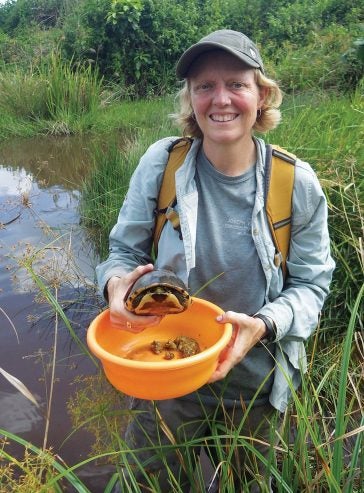Science literacy is critical—if people don’t understand what causes global warming and why it’s a problem, they won’t care about or participate in curbing it. But for science to be understood, it has to be communicated clearly. That’s the goal of SciWrite, a program that trains students to translate complex science so that even non-scientist audiences—the public and policymakers, for example—can understand it. How can you up your science literacy? Read on.

Photo: Dana Drake
Scientists don’t get political.
Nancy Karraker heard this often as a student studying wildlife and conservation biology. “I was told, ‘You are not to be an advocate. Be impartial,’” she says. “But science literacy in America is on the decline. It’s our obligation to be advocates.”
An associate professor in the College of the Environment and Life Sciences, Karraker also has a master’s in teaching writing. She is one of the professors behind SciWrite, a program offering a two-year graduate certificate in science writing and rhetoric, as well as workshops, courses, and internships to URI’s academic community.
In the two-year program, students take courses in writing in the natural sciences, public engagement with science, ethics, and multi-media. They also complete a four- to six-week internship in which they translate an organization’s science into accessible writing: blogs, press releases, grant proposals, podcasts, etc.
“We would like to become known as the place to go to get training in science writing,” Karraker says.
At a moment in time when misinformation is rampant and scientific fact is challenged, programs like SciWrite are of vital importance. Increasing the public’s capacity and confidence in their knowledge of science, Karraker says, “will make them more likely to understand, for example, what a changing climate means for our coastal communities, how choices we make at the grocery store affect how much plastic ends up in our oceans, and how the purchase of a frog or turtle from the local pet store may contribute to the species’ extinction from the wild.” •
–Marybeth Reilly-McGreen
You Can Build Your Science Literacy Too—Here’s How:
Use trusted sources of information:
- theconversation.com/us Fact-based journalism from experts
- envirobites.org Expert summaries of recent environmental science research. Sister sites: oceanbites.org and astrobites.org
- kids.frontiersin.org Frontiers for Young Minds, an open-access scientific journal written by scientists, reviewed by kids
- nationalgeographic.org Familiar, trusted, 130-year-old global nonprofit focused on science and exploration
Become an environmental activist:
- Attend a protest march.
- Write to your state representatives.
- Join a land trust—an organization dedicated to purchasing and protecting open space.
- Join a community science organization such as URI’s Watershed Watch, which enlists the public in testing local bodies of water: uri.edu/watershedwatch.
- Monitor wetlands and frog communities with Roger Williams Park Zoo’s Frog Watch: rwpzoo.org/frogwatch.
- Join a global community of naturalists contributing to a database serving conservation biology efforts through inaturalist.org.
Read! Dive into these books:
- Bird by Bird: Some Instructions on Writing and Life, by Anne LaMott
- At the Water’s Edge: Fish with Fingers, Whales with Legs, and How Life Came Ashore but Then Went Back to Sea, by Carl Zimmer
- Classic Krakauer: Essays on Wilderness and Risk, by Jon Krakauer
- On Writing: A Memoir of the Craft, by Stephen King
- Cod: A Biography of the Fish that Changed the World, by Mark Kurlansky
- The Everglades: River of Grass, by Marjorie Stoneman Douglas
